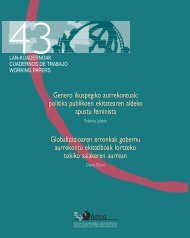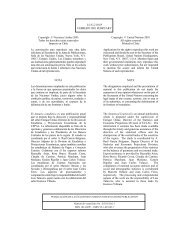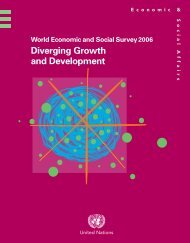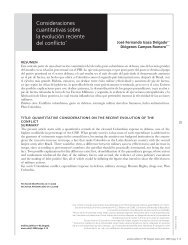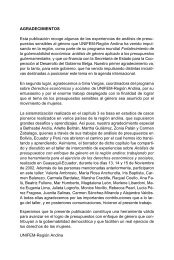OECD Economic Outlook 69 - Biblioteca Hegoa
OECD Economic Outlook 69 - Biblioteca Hegoa
OECD Economic Outlook 69 - Biblioteca Hegoa
Create successful ePaper yourself
Turn your PDF publications into a flip-book with our unique Google optimized e-Paper software.
Substantial progress has been made over the past year in<br />
restoring the soundness of the banking system in the three<br />
Asian non-<strong>OECD</strong> countries hardest hit by the 1997 crisis<br />
– Indonesia, Malaysia, and Thailand. The approaches being<br />
taken to bank restructuring have also converged somewhat,<br />
with separate bank asset management companies now playing<br />
a key role in all three countries in dealing with non-performing<br />
loans. Bank restructuring is being accompanied by efforts to<br />
improve prudential standards and bolster governance. The<br />
banking landscape is undergoing significant changes with<br />
many banks either being merged, closed or having greater<br />
foreign participation. However, the restructuring process is<br />
still incomplete and subject to risks of a setback given the<br />
more limited progress that has been made in resolving<br />
non-financial corporate debt problems. Other future challenges<br />
are to dispose of the problem loans acquired from the banks, to<br />
re-privatise banks acquired by the governments in the<br />
aftermath of the 1997 crisis and to deal with the large and still<br />
growing costs of the bank restructuring itself.<br />
Of the three countries, Malaysia is furthest along in its<br />
bank restructuring process. Danaharta, the bank asset management<br />
agency created by the government in 1998, completed<br />
its acquisition of non-performing bank loans<br />
(amounting to about 12 per cent of total commercial bank<br />
loans) in 2000. Remaining non-performing loans, net of provisions,<br />
had fallen to 9.6 per cent of total bank loans by the<br />
end of 2000. Danaharta also made substantial progress in<br />
working out the assets acquired from the banks and the<br />
recovery rate has been rising. Capital injections of<br />
RM 7.6 billion ($2 billion) of public funds have helped to<br />
bring banks’ core capital adequacy ratio to 12.1 per cent in<br />
January 2001, substantially above the minimum set by the<br />
Bank for International Settlements (BIS). Despite several setbacks,<br />
the government’s ambitious plan to restructure the<br />
banking sector made significant progress in 2000 with the<br />
establishment of six of the ten core financial groups ultimately<br />
envisaged. Significant but less progress has been<br />
made in corporate debt restructuring, which has been hindered<br />
by government protection of some strategic enterprises<br />
and restrictions on foreign ownership in certain areas.<br />
further restore confidence, a new economic team was appointed in late March 2001,<br />
which announced a plan to improve competitiveness in the economy.<br />
The slowing US growth, weakening information and communications technology<br />
trends and global effects induced by adjustments in this sector, are less important<br />
directly for South America than for Asia. But, of course, a global economic downturn<br />
would have important spillover effects. For Chile and Peru, in particular, slowing<br />
demand in Asia would be a downside risk as it could significantly affect their<br />
primary commodity exports. A significant fall in oil prices would also be a major<br />
risk for South American oil exporting countries. It would lead to fiscal and external<br />
imbalances in Venezuela, Ecuador and Colombia and could trigger political and<br />
social unrest. For the area as a whole, the impact of lower world growth could be<br />
Developments in selected non-member economies - 139<br />
Box III.1. Banking sector restructuring in Asian crisis countries<br />
Compared to Malaysia, Thailand’s restructuring of its private<br />
banks has relied more heavily on the efforts of the banks<br />
themselves. The private banks have been responsible for<br />
establishing asset management companies to carve out their<br />
non-performing loans. Most banks have chosen to raise capital<br />
in the market to meet the progressively higher requirements<br />
set by supervisory authorities rather than participate in<br />
the government’s voluntary re-capitalisation programme.<br />
Indeed, banks have had substantial success in raising capital<br />
from domestic and foreign investors, and managed to raise<br />
their capital adequacy ratio to 11.4 per cent by the end<br />
of 2000. However, non-performing bank loans declined gradually<br />
and were still above 30 per cent of total loans as late as<br />
August 2000. They have since dropped much further to<br />
below 20 per cent, as banks transferred assets to their<br />
recently established asset management companies and as the<br />
maturity of loans rescheduled earlier was extended. But new<br />
non-performing loans continue to emerge, remaining nonperforming<br />
loans are proving to be more difficult to restructure,<br />
and banks appear reluctant to write down bad loans.<br />
Progress on non-financial corporate sector debt restructuring<br />
has also been more limited and there continues to be “strategic<br />
withholding” of loan payments by some corporations that<br />
are able to repay.<br />
Despite its exceptionally severe economic problems,<br />
Indonesia has also made considerable progress toward restoring<br />
its banks to financial soundness. By the end of 2000, the<br />
government-established Indonesia Bank Restructuring Agency<br />
(IBRA) had carved out 82.6 per cent of banking sector nonperforming<br />
loans, bringing the overall non-performing ratio<br />
down to 18.8 per cent. However, less than 3 per cent of the<br />
assets acquired had been disposed of by early this year. The<br />
government programme to inject capital into three state banks<br />
and three private banks was completed in October 2000,<br />
although it was only able to raise their average capital adequacy<br />
ratio to 4 per cent, or half the BIS minimum. Further<br />
progress in bank restructuring continues to be limited by the<br />
weakness of the economy and especially by the non-financial<br />
corporate debt overhang. Corporate debt restructuring has<br />
been gaining momentum but bad debts remain massive.<br />
The slowdown in the United<br />
States is expected to have a<br />
limited impact on the region<br />
© <strong>OECD</strong> 2001



